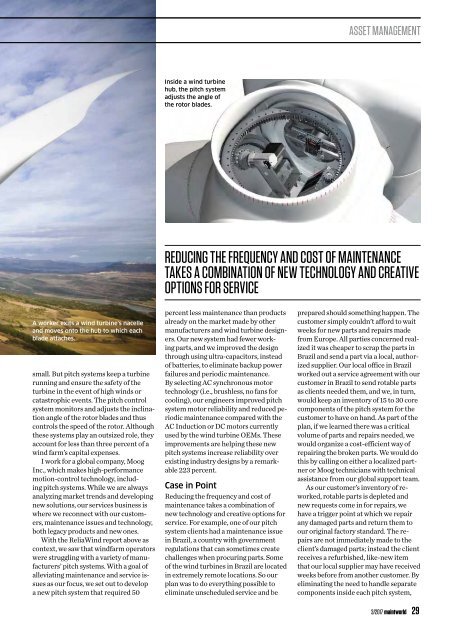Maintworld 3/2017
In this issue: Using Technology and Innovation to Manage Mega-Maintenance Challenges Identify the Root Cause of a Misalignment Condition Elements of a Good Preventive Maintenance Program
In this issue:
Using Technology and Innovation to Manage Mega-Maintenance Challenges
Identify the Root Cause of a Misalignment Condition
Elements of a Good Preventive Maintenance Program
Create successful ePaper yourself
Turn your PDF publications into a flip-book with our unique Google optimized e-Paper software.
ASSET MANAGEMENT<br />
Inside a wind turbine<br />
hub, the pitch system<br />
adjusts the angle of<br />
the rotor blades.<br />
REDUCING THE FREQUENCY AND COST OF MAINTENANCE<br />
TAKES A COMBINATION OF NEW TECHNOLOGY AND CREATIVE<br />
OPTIONS FOR SERVICE<br />
A worker exits a wind turbine’s nacelle<br />
and moves onto the hub to which each<br />
blade attaches.<br />
small. But pitch systems keep a turbine<br />
running and ensure the safety of the<br />
turbine in the event of high winds or<br />
catastrophic events. The pitch control<br />
system monitors and adjusts the inclination<br />
angle of the rotor blades and thus<br />
controls the speed of the rotor. Although<br />
these systems play an outsized role, they<br />
account for less than three percent of a<br />
wind farm’s capital expenses.<br />
I work for a global company, Moog<br />
Inc., which makes high-performance<br />
motion-control technology, including<br />
pitch systems. While we are always<br />
analyzing market trends and developing<br />
new solutions, our services business is<br />
where we reconnect with our customers,<br />
maintenance issues and technology,<br />
both legacy products and new ones.<br />
With the ReliaWind report above as<br />
context, we saw that windfarm operators<br />
were struggling with a variety of manufacturers’<br />
pitch systems. With a goal of<br />
alleviating maintenance and service issues<br />
as our focus, we set out to develop<br />
a new pitch system that required 50<br />
percent less maintenance than products<br />
already on the market made by other<br />
manufacturers and wind turbine designers.<br />
Our new system had fewer working<br />
parts, and we improved the design<br />
through using ultra-capacitors, instead<br />
of batteries, to eliminate backup power<br />
failures and periodic maintenance.<br />
By selecting AC synchronous motor<br />
technology (i.e., brushless, no fans for<br />
cooling), our engineers improved pitch<br />
system motor reliability and reduced periodic<br />
maintenance compared with the<br />
AC Induction or DC motors currently<br />
used by the wind turbine OEMs. These<br />
improvements are helping these new<br />
pitch systems increase reliability over<br />
existing industry designs by a remarkable<br />
223 percent.<br />
Case in Point<br />
Reducing the frequency and cost of<br />
maintenance takes a combination of<br />
new technology and creative options for<br />
service. For example, one of our pitch<br />
system clients had a maintenance issue<br />
in Brazil, a country with government<br />
regulations that can sometimes create<br />
challenges when procuring parts. Some<br />
of the wind turbines in Brazil are located<br />
in extremely remote locations. So our<br />
plan was to do everything possible to<br />
eliminate unscheduled service and be<br />
prepared should something happen. The<br />
customer simply couldn’t afford to wait<br />
weeks for new parts and repairs made<br />
from Europe. All parties concerned realized<br />
it was cheaper to scrap the parts in<br />
Brazil and send a part via a local, authorized<br />
supplier. Our local office in Brazil<br />
worked out a service agreement with our<br />
customer in Brazil to send rotable parts<br />
as clients needed them, and we, in turn,<br />
would keep an inventory of 15 to 30 core<br />
components of the pitch system for the<br />
customer to have on hand. As part of the<br />
plan, if we learned there was a critical<br />
volume of parts and repairs needed, we<br />
would organize a cost-efficient way of<br />
repairing the broken parts. We would do<br />
this by calling on either a localized partner<br />
or Moog technicians with technical<br />
assistance from our global support team.<br />
As our customer’s inventory of reworked,<br />
rotable parts is depleted and<br />
new requests come in for repairs, we<br />
have a trigger point at which we repair<br />
any damaged parts and return them to<br />
our original factory standard. The repairs<br />
are not immediately made to the<br />
client’s damaged parts; instead the client<br />
receives a refurbished, like-new item<br />
that our local supplier may have received<br />
weeks before from another customer. By<br />
eliminating the need to handle separate<br />
components inside each pitch system,<br />
3/<strong>2017</strong> maintworld 29

















